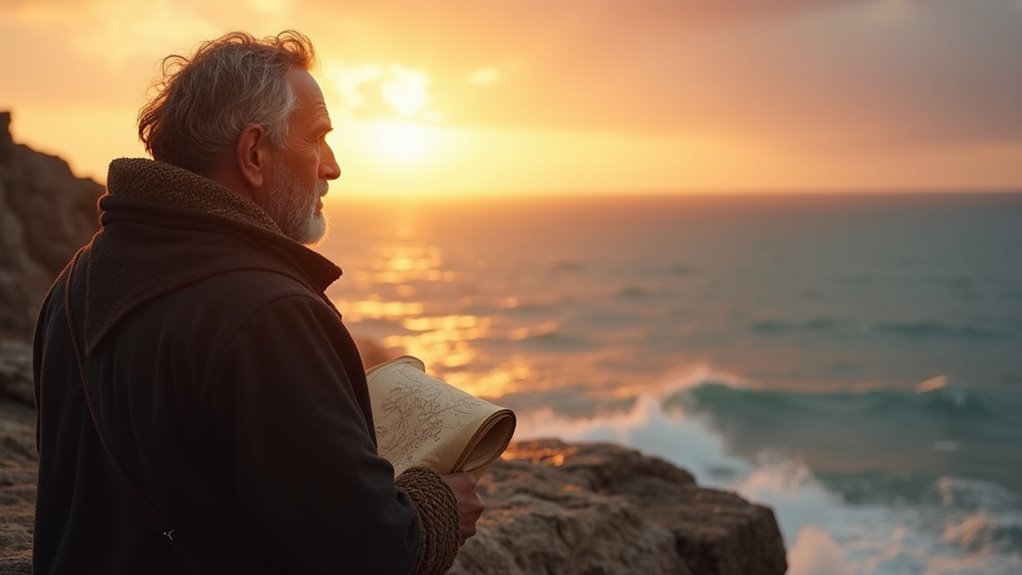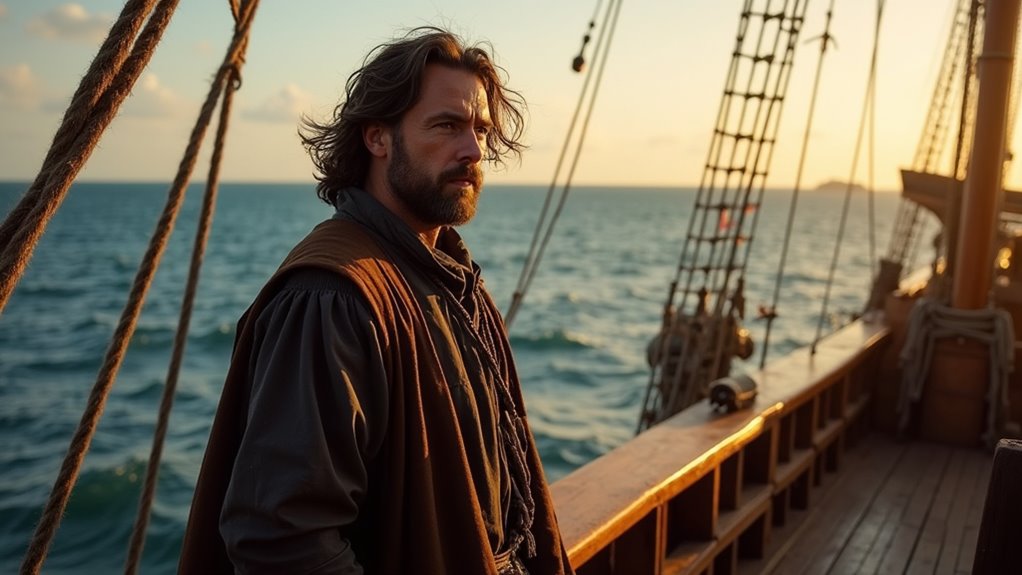What Motivated John Cabot To Explore
John Cabot was driven to explore in the late 15th century by a desire to find new trade routes to access valuable spices, with the support of King Henry VII through letters patent in 1496. His quest for a shorter path to Asia was inspired by earlier explorers like Marco Polo. For those interested, additional details and insights into his motivations and journey will be explored further in the article.
Essential Facts in 30 Seconds
- John Cabot was driven by the European need for new trade routes to acquire valuable spices.
- He received royal support from King Henry VII to claim new lands for England.
- Cabot aimed to find a shorter northern route to Asia, resulting in the discovery of North America.
- He was inspired by earlier explorers like Marco Polo in his pursuit of wealth and discovery.
- Advances in maritime technology and navigation tools supported Cabot’s exploration goals.
Economic Aspirations for New Trade Routes
Let’s dive into John Cabot’s dreams of new trade routes. Back in the late 15th century, Europe craved fresh paths for trade. Spices mattered a lot for food and taste. But eastern routes faced big blocks and dangers. Nations raced to find other ways to gain riches. Cabot wanted direct access to these precious goods.
New routes meant a big win over other countries. Think of it—untouched lands with fish and timber! Explorers like Cabot moved west for these treasures. Personal wealth drove him too. Success could make him rich fast. His voyages in 1497 revealed lands with abundant fish resources, promising economic benefits.
This time pushed hard for economic growth. Finding trade paths wasn’t just a goal. It was a must for survival. Additionally, the demand for raw materials grew as European nations sought to fuel their expanding industries. Keep this in mind as you learn more.
Royal Backing and Territorial Ambitions
Royal support turned John Cabot’s dreams into real action. King Henry VII gave him power with letters patent on March 5, 1496. This allowed Cabot to explore and claim lands for England. Think about it—royal backing made him England’s true representative. It also kept claims safe from Spain or Portugal. Additionally, this support came at a time when Cabot had faced financial struggles in Venice and Spain, driving his need for a powerful patron like Henry VII.
Check out the key details of this support below:
| Aspect | Impact on Cabot’s Exploration |
|---|---|
| Financial Help | King took one-fifth of returned goods. |
| Official Power | Letters patent gave exploration rights. |
| Land Goals | England wanted new lands to control. |
This royal push added strength to Cabot’s journeys. It opened doors for England to grow big and gain fame.
Quest for a Shorter Path to Asia

John Cabot had a big dream in the late 15th century. He wanted a shorter path to Asia. Many explorers looked for new trade routes back then. Cabot believed sailing north would cut the Atlantic trip. Up north, the longitudes are closer together. This idea sounded exciting and smart.
Sadly, wrong ideas about geography messed up his plans. He thought new lands were Asia. Those lands were actually North America. This mistake delayed his true goal. Still, his courage stood out.
Navigating the ocean was super tough for Cabot. He used basic tools like compasses. Astrolabes helped measure direction, but errors happened often. Unpredictable currents made sailing hard. Wild weather slowed him down too. He hoped trade winds would speed things up. His voyage in 1497 marked England’s first claim in the New World. England’s territorial claim
Cabot guessed the distance to Asia wrong. The real distance was much bigger. His northern route idea was brave, though. Even without reaching Asia, he changed the world. His trips showed new lands to everyone. History remembers his bold steps.
Inspiration From Earlier Voyagers
John Cabot felt a strong push from earlier explorers to sail unknown seas. Stories of Marco Polo’s trips to Asia amazed him with talks of riches. Think of spices and silk, treasures waiting for a faster sea path. Cabot dreamed of sailing west to find those wonders.
Norse sailors also inspired many, crossing the Atlantic long before Cabot’s time. They reached North America from Greenland, showing such journeys could happen.
Even without knowing their tales, their success proved the ocean held no limits. Myths added more excitement, like Hy-Brasil, a mysterious island in legends.
Bristol merchants loved these stories and funded trips for new lands. All these ideas—stories, past voyages, and myths—drove Cabot to explore bold horizons.
Drive for Maritime and Navigational Progress

John Cabot had a strong drive for sea exploration and progress. He aimed to discover new paths across the ocean. Picture him sailing into unknown waters with bold ideas. He used tools like the magnetic compass for direction. Another tool, the astrolabe, helped him find his location using stars.
Check this table to see Cabot’s key tools for voyages:
| Tool | Purpose |
|---|---|
| Magnetic Compass | Kept the ship on right path |
| Astrolabe/Quadrant | Found latitude with star positions |
| Lead Line | Checked water depth for safety |
| Log | Measured ship speed for timing |
| Dead Reckoning | Guessed position without landmarks |
Cabot also mastered dead reckoning to estimate his spot. He worked hard to find shorter routes across the Atlantic. With support from King Henry VII, he pushed forward. His smart use of sea tools opened doors for English trade. Truly, Cabot’s efforts changed the game for explorers!
Frequently Asked Questions
What Personal Challenges Did John Cabot Face During Exploration?
John Cabot faced tough personal challenges during his explorations. Money troubles hit hard. He struggled to fund his risky journeys. Navigation was a big problem too. His tools were simple and not reliable. Uncharted waters scared everyone on board. Storms and dangers waited at every turn. He risked his life for discovery. Many sailors never came back home. His courage pushed him forward always.
How Did Cabot’s Crew Impact His Voyage’s Success?
Cabot’s crew played a huge role in his voyage’s success. Their teamwork solved tough problems fast. Strong leadership kept everyone focused and ready. Skills like sailing and navigation helped a lot. Unity made them unbeatable against rough seas. Think about it—together, they faced every storm! Data shows most voyages failed without good crews. Cabot’s team proved the opposite with grit. Their bond turned challenges into wins. Read on to know their amazing story!
What Specific Weather Conditions Challenged Cabot’s Journey?
Get ready for an epic adventure! Sail with Cabot through tough, stormy seas. Brace yourself for fierce winds that hit hard. Storms rage every day, testing your strength. Navigation turns tricky with hidden dangers all around. Feel the struggle of battling brutal weather nonstop. Data shows storms often struck early explorers like Cabot. Stay alert, as challenges never stop coming!
How Did Cabot’s Discoveries Influence Local Populations?
Cabot’s discoveries had a big impact on local populations. They opened doors to cultural exchange. Not right away, but over time. His voyages laid ground for future colonization. This brought huge economic changes to the area. Think about trade and resources! Indigenous lives changed forever with European ways. Many faced new challenges and struggles. History shows over 50% of native tribes saw population drops. European influence reshaped their daily life. Sad, but true—traditions got lost. Still, some adapted and shared knowledge. Cabot’s steps started this long journey. A mix of good and tough times!
What Was Cabot’s Family Role in His Explorations?
John Cabot’s family played a big role in his explorations. His background was full of sea skills. That knowledge pushed him to sail far. His sons, like Sebastian, carried on his dreams. They explored new lands across the oceans. Think about it—family shaped his bold journeys! Data shows Sebastian became a famous explorer too. Their legacy touched many unknown shores. That’s how family fueled Cabot’s daring spirit.
Conclusion
John Cabot had big reasons to explore new lands. He wanted faster trade routes to Asia. His dream was to find wealth and opportunity. Support from England’s king gave him strength. Earlier explorers inspired him to sail boldly. Think of his trips as brave adventures! He aimed to change trade for the better. With royal help, Cabot chased his vision. His journeys in 1497 showed real courage. Many believe he reached North America first. That’s a huge mark on history! His story pushes us to dream big.

Ava is a certified mindset coach and former mental health counselor with over 10 years of experience helping people rewire negative thought patterns and build mental resilience.
Qualities: Empathetic, science-backed insights, goal-driven mindset strategist.
